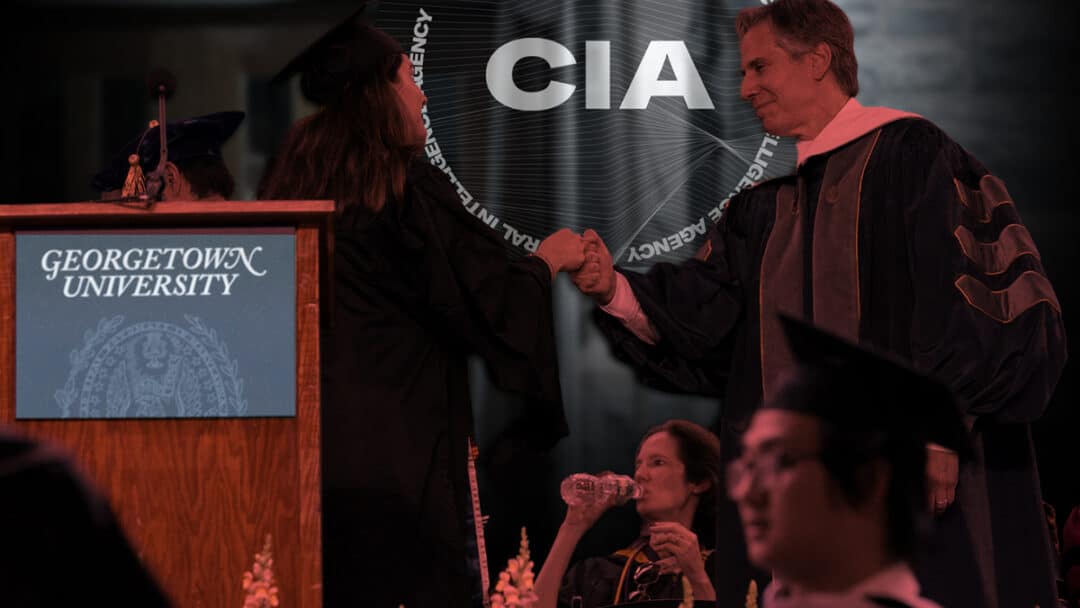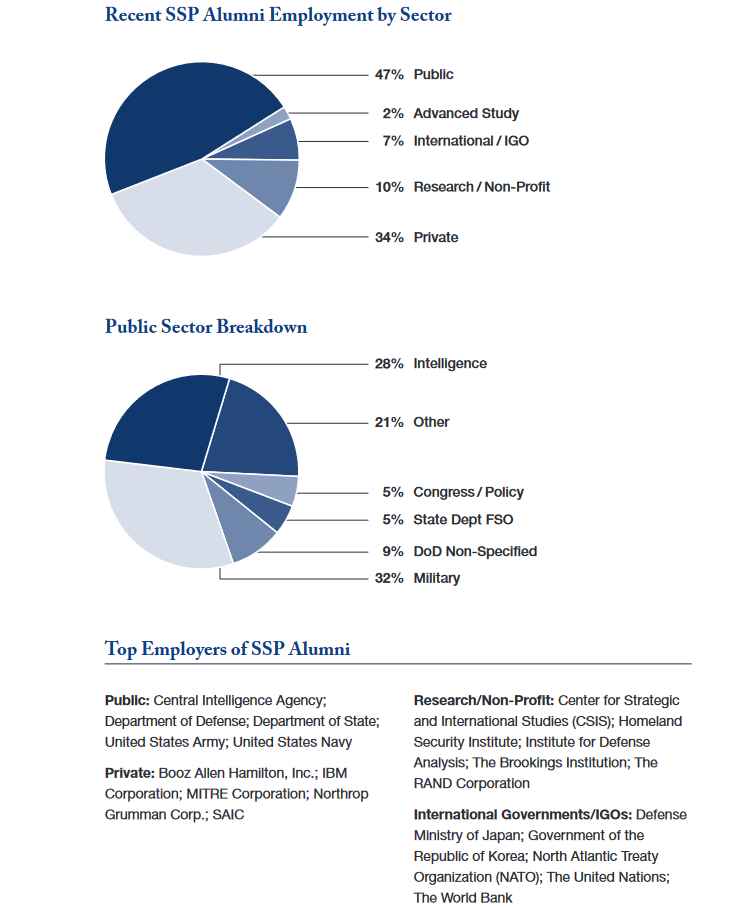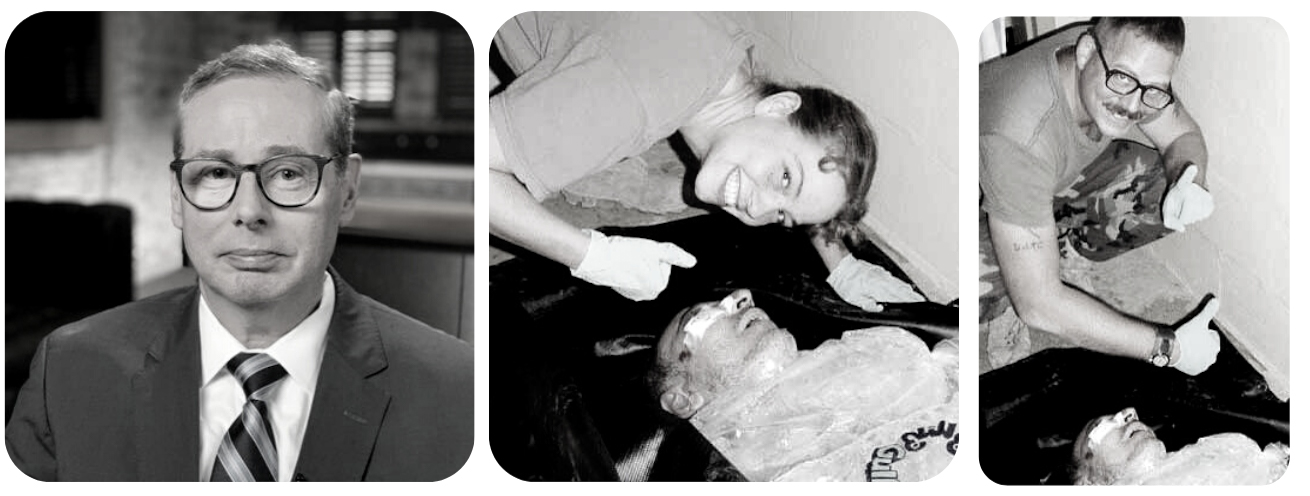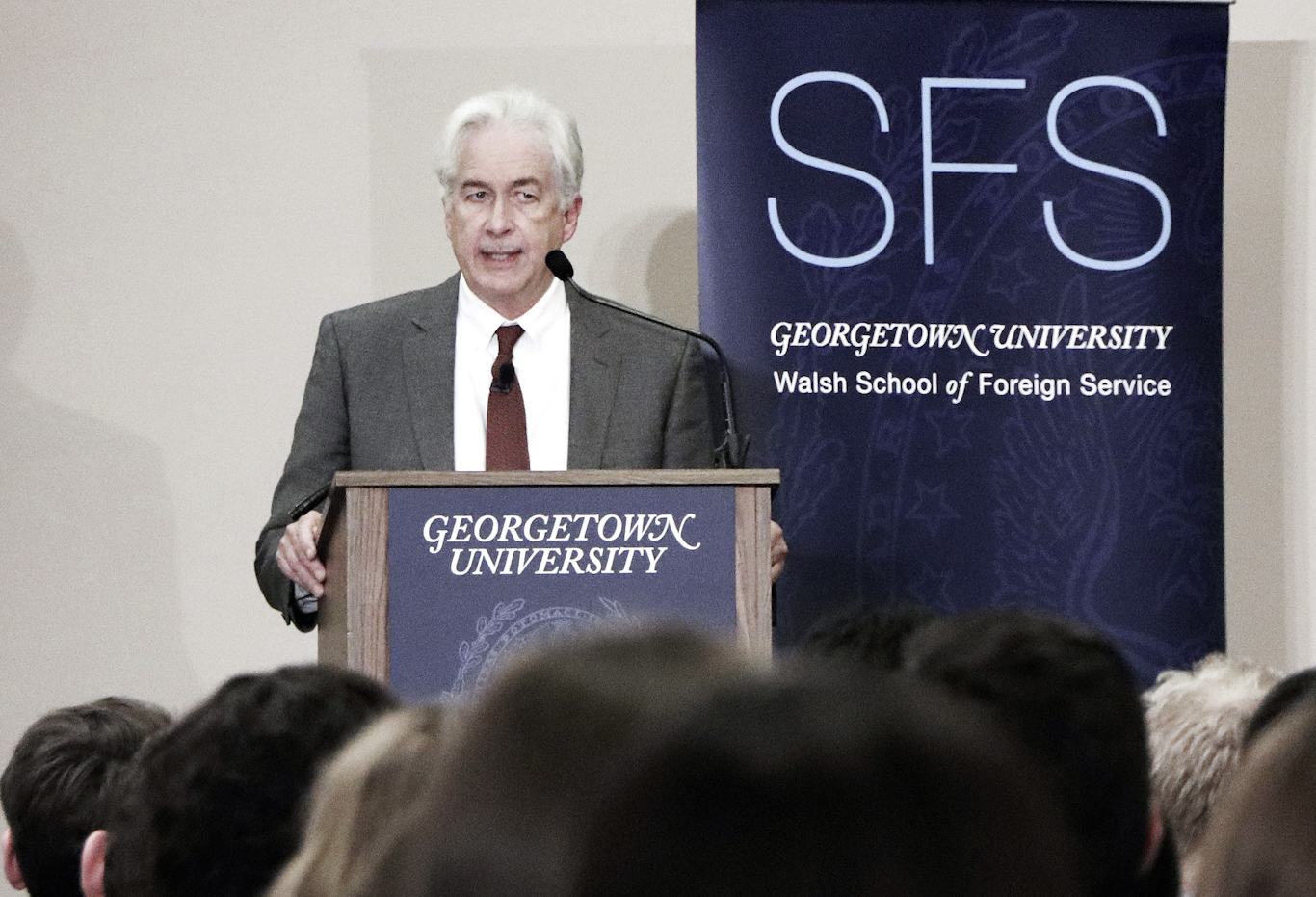Subscribe to Zero-Sum Pfear & Loathing



by Alan Macleod | Mar 15, 2023
If you have ever wondered, “where do America’s spies come from?” the answer is quite possibly the Walsh School of Foreign Service (SFS) at Georgetown University. It is only a modestly-seized institution, yet the school provides the backbone for the Central Intelligence Agency, Department of Defense, State Department, and other organs of the national security state.
From overthrowing foreign governments and conducting worldwide psychological operations to overseeing drug and gun smuggling and a global torture network, the CIA is perhaps the world’s most controversial and dangerous organization. All of which begs the question, should an educational institution have any formal relationship with it, let alone such a storied school as Georgetown?
Yet, with more than two dozen ex-CIA officials among its teaching staff, the school tailors its courses towards producing the next generation of analysts, assassins, coup-plotters and economic hitmen, fast-tracking graduates into the upper echelons of the national security state.
The CIA has also quietly funded the SFS, as journalist Will Sommer revealed. The agency, based in Langley, VA, secretly donated hundreds of thousands of dollars to fund the department’s work, despite Georgetown insisting on its website that this money came from anonymous donations from individuals.
Any number of “how to join the CIA” articles suggest studying at the School of Foreign Service, and the university itself leans into its reputation as a spy factory. “We have global thinkers in Georgetown… They are attractive to the intel community in both the public and private sectors,” Anne Steen, then-executive director of the SFS’ graduate career center, told CNBC in 2018, adding, “There are elements to intelligence that didn’t even exist ten years ago whether it is cyber or artificial intelligence, and our students are on the cutting edge.”
There were 377 SFS graduates in academic year 2021, pursuing courses in security studies, foreign service, or a range of area-specific degrees, including Arab, Asian, Latin American or Eurasian and East European Studies.
Perhaps the most CIA-specific degree on offer is security studies, with Georgetown itself claiming that “we offer a multidisciplinary master’s degree designed to prepare graduates for positions within the defense and security fields” and that the staff “recognize the benefit of having students who are currently working or interning in the security field.” In other words, CIA agents often go back to Georgetown to acquire skills that an academic environment can offer.
According to Georgetown’s own reports, 47% of security studies graduates “quickly go into the public sector,” the lion’s share finding work in intelligence or the military. The CIA is the number one public employer of security studies grads, followed by the Department of Defense, Department of State, the Army and the Navy. The top private-sector employers are largely military contractors, including Booz Allen Hamilton, SAIC and Northrop Grumman. The report claims that those working in the world of intelligence and security consider a School of Foreign Service security studies degree to be a “must have” credential.

A breakdown of the most common career paths of Georgetown Security Studies graduates. Source | Edmund A. Walsh School of Foreign Service
Last month, the SFS invited current CIA Director William J. Burns to campus, where it presented him with the Trainor Award for Excellence in the Conduct of Diplomacy. Burns turned the event into a recruitment drive, stating in his speech: “Nothing has ever given me greater pride than to serve my country with honor. It’s a lesson that I’ve learned and relearned over the past four decades, and I hope all the students in this audience will explore its promise.”
Burns’ words echoed those of his CIA predecessor Leon Panetta, who, in addition to being the agency’s chief, was also Secretary of Defense. During a speech at Georgetown, Panetta praised the institution’s “leadership in the study of global security.” As he explained,
I have had a deep and abiding respect for Georgetown throughout the almost 40 to 50 years that I’ve been involved in public service. And I have a deep respect for the generation of leaders that have gone forward from this campus to serve our nation.”
Panetta added that, throughout his time in the national security state, he was surrounded by Georgetown graduates, describing them as:
Talented, young individuals who have been at my side every day for the last four years, at both the CIA and the Pentagon, and I am deeply grateful for their work on behalf of me and on behalf of the nation. And I’m deeply grateful to Georgetown for training such extraordinary public servants.”
In addition to training spies, the SFS also produces many of the country’s top journalists, including alternative media host Saagar Enjeti. When Enjeti left his job as host of The Hill’s show, “Rising,” he was replaced by another SFS graduate, Emily Miller. Interestingly, Enjeti himself was a replacement for original host Buck Sexton, a former CIA analyst.
It is not just the students, however, that are associated with the Central Intelligence Agency. Studying the faculty, MintPress found at least 25 staff at the School of Foreign Service alone who once worked for or with the agency. There were many other former CIA agents in other departments, while other SFS staff also worked at different institutions within the national security state.
Although the full extent of their activities remains classified and unknown to the public, many of these academics’ biographies hint at a dark past. For example, Michael Walker spent 29 years at the CIA before joining the SFS’ Center for Security Studies (CSS) as an adjunct professor,
During the 1980s, Walker was stationed in Afghanistan, where he presumably played a role in Operation Cyclone, the CIA’s arming and training of Osama bin Laden and the Mujahideen to oppose the Soviet invasion. Bin Laden would later use his skills to attack the U.S. on September 11, 2001. Walker would later return to Afghanistan to help the CIA oversee the U.S. occupation of the country. He eventually became the CIA’s Near East and South Asia Director, putting him directly in charge of CIA operations across the region.
Around six million people have been killed and between 37 and 59 million displaced as a result of American actions in the region in the past two decades.
Another CSS academic with a similarly dark past is Douglas London. London enjoyed a 34-year stint at the CIA, where he worked as a senior operations officer, a chief of station, and the agency’s counterterrorism chief for South and Southwest Asia.
During London’s time in that region, the CIA was involved in attacking Iraq, Afghanistan, and Syria and the bombing of Pakistan and Yemen. Perhaps most infamously, however, it also oversaw the notorious Abu Ghraib prison, where CIA officers routinely tortured and raped victims, including children.

Douglas London (left), now a Georgetown professor, was CIA Counterterrorism Chief during the infamous Abu Ghraib torture scandal, which saw CIA agents brutally torture captives in Iraq
Manadel al-Jamadi was beaten and tortured to death inside the prison. His identity and fate were completely unknown until 2004 when images of grinning U.S. officials posed with their thumbs up beside his body.
While there is no evidence that London was directly involved with Abu Ghraib, the fact that he was a CIA leader during the darkest days of the post-9/11 wars in the Middle East should be a black mark against him, not an asset that gets him a job at one of America’s most prestigious universities.
Other CIA-linked academics at the School of Foreign Service include:
• Paula Doyle. Currently an adjunct professor of practice at the SFS’ Center for Security Studies (CSS), in 2016, Doyle retired from an 18-year career at the agency, where she rose to become associate deputy director of operations. Between 2012 and 2014, she was deputy national counterintelligence executive and oversaw the U.S. response to the Edward Snowden and Chelsea Manning leaks.
• Burton Gerber. Another CSS professor, Gerber spent 39 years in the CIA. His work focussed on the Soviet Union and Eastern Europe. He was the CIA chief of station in three former Warsaw Pact countries.
• Scott Modell. In his 13-year career, which saw him become a senior officer in the CIA’s National Clandestine Service, Modell specialized in Iran and Latin America, where he served multiple tours. After leaving the agency, he worked as a special advisor to U.S. Special Operation Command and as a fellow of the Center for Strategic and International Studies (CSIS), a hawkish Washington think tank. An SFS graduate himself, since 2019, he has taught security studies at Georgetown.
• Sue Terry. Another former CSIS fellow, Terry was a senior analyst for the CIA between 2001 and 2008, specializing in Korean issues. She later joined the National Security Council and was deputy national intelligence officer for East Asia and Oceania. Today, she teaches Asian Studies at the SFS.
• Dennis Wilder. Wilder spent more than 30 years working in intelligence, the culmination of which came in 2015 when the CIA appointed him deputy assistant director for East Asia and the Pacific. A Georgetown graduate, he now teaches at the SFS.
• David Robarge. Robarge joined the CIA in 1989 and became a political and leadership analyst on the Middle East. He was appointed chief historian of the agency in 2005. He is now an adjunct professor within the CSS.
• Paul Pillar. Currently a non-resident senior fellow at the CSS, professor Pillar spent 28 years in the U.S. intelligence community, serving in a number of senior roles, including as the executive assistant to the CIA director William Webster.
• Paul Miller. Not to be confused with Paul Pillar, Paul Miller is a Professor in the Practice of International Affairs at the SFS. A White House staffer under both the Bush and Obama administrations, he also worked for the National Security Council, as an intelligence analyst for the CIA and in military intelligence for the U.S. Army.
• Joseph Gartin. After a long career, Gartin retired from the CIA in 2019, where he served as deputy associate director for talent and as chief learning officer. To this day, however, he is the managing editor of Studies in Intelligence, the CIA’s in-house journal. At Georgetown, he is a practitioner in residence of the university’s master of science in foreign service program.
• Matthew Kroenig. Before joining academia, Kroenig held a wide range of senior positions in the U.S. national security state, including in the Office of the Secretary of Defense and at the CIA. In addition to being a professor in the SFS, he is a senior member of the Atlantic Council, a NATO think tank.
• Anand Arun. With nearly two decades of experience in the field, Arun is a senior intelligence officer at the Defense Intelligence Agency and an adjunct assistant professor at the CSS. Between 2018 and 2020, he worked at CIA headquarters in Langley, VA, as the President’s Daily Briefer to the Chairman and Vice Chairman of the Joint Chiefs of Staff.
• Kenneth Pollack. Pollack began his career as a Persian Gulf military analyst at the CIA and was later Director for Near East and South Asian Affairs and Director for Persian Gulf Affairs. He currently teaches at the CSS.
• Andrew Borene. In addition to being a CSS adjunct assistant professor, Borene is currently the associate vice president of research at the Office of the Director of National Intelligence University. His Georgetown biography notes that he worked as an advisor to leaders at the CIA.
• Catherine Lotrionte. Lotrionte is the director of the Institute for Law, Science and Global Security and a visiting assistant professor of government and foreign service at Georgetown. Prior to that, she was Assistant General Counsel at the CIA’s Office of General Counsel and a counsel on the president’s Foreign Intelligence Advisory Board at the White House.
• Laura Manning Johnson. Early in her national security career, Manning Johnson was a biological warfare analyst at the CIA. After 9/11, she was detailed to the White House as the first Director of Central Intelligence Representative to the Office of Homeland Security, as well as a member of Vice-President Dick Cheney’s Weapons of Mass Destruction Review. She is now an adjunct professor at the SFS.
• John Gentry. Gentry teaches an undergraduate course at Georgetown on the U.S. intelligence community. He has extensive experience in the subject, having spent 12 years at the CIA working as an intelligence analyst.
• Jonathan Massicot. In addition to his role at the CSS, Massicot is the senior political-military advisor on Russia for the Office of the Joint Chiefs of Staff. Between 2008 and 2021 worked as a senior analyst at the CIA.
• Bruce Hoffman. A tenured professor at the SFS, Hoffman was scholar-in-residence for counterterrorism at the Central Intelligence Agency between 2004 and 2006 and also an advisor on counterterrorism to the Office of National Security Affairs.
• Russell Rumbaugh. Rumbaugh left his position at the CSS in January to become Assistant Secretary of the Navy (Financial Management and Comptroller). Between 2004 and 2005, he was a military analyst at the CIA.
• William Costanza. Now an adjunct assistant professor at the CSS, Costanza came to Georgetown after a 25-year career as a CIA case officer, where he specialized in targeting and intelligence collecting.
• Candice Frost. Colonel Frost completed a war college fellowship at the CIA and then served as the Director of Foreign Intelligence for the Army G-2 at the Pentagon. She currently teaches at the CSS.
• Richard Schroeder. After a long career as a CIA officer, Schroeder became an adjunct associate professor at Georgetown, teaching a number of graduate and undergraduate courses within the SFS.
• Marie Harf. Harf began her career with the CIA in 2006, first serving as a Middle East analyst, then as the agency’s media spokesperson. Between 2013 and 2017, she worked as the State Department’s deputy media spokesperson. Today, she is the executive director of external relations and marketing for the SFS.
The biographies of many of these individuals suggest that they were intimately involved in many of the CIA’s most infamous operations. Added to that, the sheer number of spies teaching at the Georgetown School of Foreign Service suggests that their role is to train, oversee and select the next generation of operatives, all done in the rarefied confines of an elite university campus.
Although Georgetown presents the organization as a respectable group defending freedom and advancing liberty, since its founding in 1947, the CIA has repeatedly been implicated in many of the worst modern-era crimes against humanity. The agency has played a central role in countless U.S. attempts to overthrow foreign governments, many of them democratically elected ones.
In Iran in 1953, the CIA successfully overthrew the secular reformist government of Mohammad Mosaddegh and installed the Shah as a dictator. Twenty years later, in Chile, it helped to overthrow the democratically elected socialist government of Salvador Allende and shored up the brutal rule of fascist military dictator Augusto Pinochet. More recently, the organization has been implicated in numerous regime change attempts against the government of Venezuela.
Maintaining America’s place as a global hegemon is no easy task and often relies on extreme cruelty. To this end, the CIA operates a worldwide network of “Black Sites” – prison camps where captives are tortured. Some of the agency’s torture techniques were directly copied from the Nazis, many of whom the CIA assisted in escaping punishment after the Second World War.

Acting CIA Director William Burns speaks about threats from China at a Georgetown University event on Feb. 2, 2023. Photo | Kyodo via AP
Gun- and drug-running are also key parts of the CIA’s repertoire. During the 1980s, the agency worked closely with its Pakistani counterpart, the ISI, to funnel $2 billion worth of arms and assistance to Afghan militants, including the now-infamous Osama bin Laden. The agency also sold weapons to Iran and used the proceeds to fund death squads in Nicaragua that would go on to carry out countless massacres against peasants, women, schoolchildren and other “soft targets.”
The CIA allegedly helped fund this dirty war against the Nicaraguan people through the sale of crack cocaine in black neighborhoods across the United States, linking far-right paramilitary armies with U.S. drug kingpins like Rick Ross. In this light, then, some might see so many ex-CIA officials at Georgetown training the next generation in their craft as deeply problematic.
Another key CIA role is to spread disinformation. Investigators in the 1970s found that over 400 American journalists were secretly either CIA agents or on its payroll, and the agency had secretly set up a wide array of magazines, newspapers and journals and published a huge number of books. This penetration of the media has likely only become more extensive in recent times.
MintPress News investigations have found the presence of dozens of “former” CIA agents working in key positions in big tech companies such as Google and Facebook, effectively deciding what the entire world sees in its newsfeeds.
The cozy relationship between Georgetown and the CIA is not a new phenomenon. In 1980, a student magazine, The Georgetown Voice, published an article discussing what it called a “special relationship” and an “unholy alliance” between the university and the CIA. In the eyes of Father Richard McSorley, a Jesuit priest and professor of Peace Studies at Georgetown, this partnership was a “disgrace,” and it was “harmful for Georgetown University to have persons on campus who represent an organization guilty of severe violations of law, morality and human dignity.” McSorley wrote the CIA off as nothing more than a “club of assassins, saboteurs and coup directors.” Despite McSorley’s denunciations, the relationship persevered. A 1986 New York Times article noted that Georgetown was the number one school for agency recruits.
Going even further back, President Nixon was known to grumble about his National Security Advisor, Henry Kissinger and his “Georgetown set.” Kissinger was a professor at the School of Foreign Service and filled the White House and the State Department with handpicked students he had taught.
To this day, the national security state is filled with Georgetown graduates. This includes no less than five living former CIA directors, former Secretary of Defense Donald Rumsfeld, current Director of National Intelligence Avril Haines, former White House Chief Strategist Steve Bannon, ex-White House Press Secretary Kayleigh McEnany, and arch neoconservative war planner Frank Gaffney (although not all of them attended the SFS). In 2020, Politico reported that Georgetown was also the top feeder school to the State Department.
If Georgetown is CIA-U, then it is perhaps unsurprising that In-Q-Tel, the CIA’s venture capitalist wing, is full to the brim with its graduates as well. In-Q-Tel was set up to nurture and sponsor new hi-tech companies that will work with the CIA to provide them with cutting-edge technology.
Searching through employment databases and social networks such as LinkedIn shows dozens of individuals who have gone through the Georgetown-to-CIA pipeline. These include Vishal Sandesara, In-Q-Tel VP of Operations, Deputy General Counsel Jeremy Joseph, Senior Partner Brian Smith, Vice President Russel Ross, and Chief Operating Officer and Executive Vice President Matt Strottman.
Washington, D.C., is full of spies; the D.C.-based International Spy Museum estimates that there are 10,000 in the city. Locals and tourists alike can even book a walking tour called “the spies of Georgetown,” led by a former CIA officer. Like so many before them, a good deal of these individuals will have started their professional careers at the School of Foreign Service. While some may balk at such a prestigious institution being used as a spy school, Georgetown has found a lucrative niche, and it is sticking to it.
Georgetown University did not respond when asked to comment on this article.